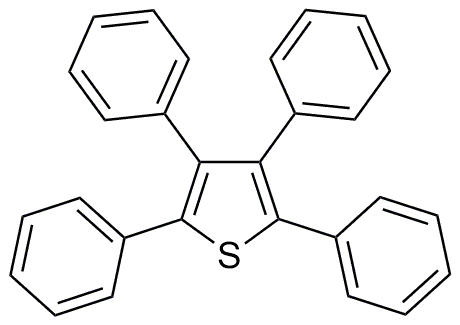2,3,4,5-Tetraphenylthiophene is widely utilized in research focused on:
- Organic Electronics: This compound is a key material in organic light-emitting diodes (OLEDs) and organic photovoltaics, enhancing device efficiency and stability.
- Conductive Polymers: It serves as a building block for synthesizing conductive polymers, which are essential in flexible electronics and advanced materials.
- Sensor Technology: The compound is employed in the development of chemical sensors and biosensors, providing high sensitivity and selectivity for various analytes.
- Photonic Devices: Its unique optical properties make it suitable for applications in photonic devices, including waveguides and optical switches, improving signal transmission.
- Research in Material Science: It is used in studies aimed at understanding charge transport mechanisms in organic semiconductors, contributing to advancements in material design.
Informations générales
Propriétés
Sécurité et réglementation
Applications
2,3,4,5-Tetraphenylthiophene is widely utilized in research focused on:
- Organic Electronics: This compound is a key material in organic light-emitting diodes (OLEDs) and organic photovoltaics, enhancing device efficiency and stability.
- Conductive Polymers: It serves as a building block for synthesizing conductive polymers, which are essential in flexible electronics and advanced materials.
- Sensor Technology: The compound is employed in the development of chemical sensors and biosensors, providing high sensitivity and selectivity for various analytes.
- Photonic Devices: Its unique optical properties make it suitable for applications in photonic devices, including waveguides and optical switches, improving signal transmission.
- Research in Material Science: It is used in studies aimed at understanding charge transport mechanisms in organic semiconductors, contributing to advancements in material design.
Documents
Fiches de données de sécurité (FDS)
La FDS fournit des informations de sécurité complètes sur la manipulation, le stockage et l’élimination du produit.
Spécifications du produit (PS)
Le PS fournit une description complète des propriétés du produit, notamment sa composition chimique, son état physique, sa pureté et les exigences de stockage. Il détaille également les plages de qualité acceptables et les applications prévues du produit.
Certificats d'analyse (COA)
Recherchez des certificats d'analyse (COA) en saisissant le numéro de lot du produit. Les numéros de lot et de lot se trouvent sur l'étiquette d'un produit, après les mots « Lot » ou « Lot de fabrication ».
Numéro de catalogue
Numéro de lot/série
Certificats d'origine (COO)
Ce certificat d'exploitation confirme le pays dans lequel le produit a été fabriqué, et détaille également les matériaux et composants utilisés et s'il est issu de sources naturelles, synthétiques ou autres sources spécifiques. Ce certificat peut être requis pour les douanes, le commerce et la conformité réglementaire.
Numéro de catalogue
Numéro de lot/série
Fiches de données de sécurité (FDS)
La FDS fournit des informations de sécurité complètes sur la manipulation, le stockage et l’élimination du produit.
DownloadSpécifications du produit (PS)
Le PS fournit une description complète des propriétés du produit, notamment sa composition chimique, son état physique, sa pureté et les exigences de stockage. Il détaille également les plages de qualité acceptables et les applications prévues du produit.
DownloadCertificats d'analyse (COA)
Recherchez des certificats d'analyse (COA) en saisissant le numéro de lot du produit. Les numéros de lot et de lot se trouvent sur l'étiquette d'un produit, après les mots « Lot » ou « Lot de fabrication ».
Numéro de catalogue
Numéro de lot/série
Certificats d'origine (COO)
Ce certificat d'exploitation confirme le pays dans lequel le produit a été fabriqué, et détaille également les matériaux et composants utilisés et s'il est issu de sources naturelles, synthétiques ou autres sources spécifiques. Ce certificat peut être requis pour les douanes, le commerce et la conformité réglementaire.


